
Crataegus, commonly called hawthorn, quickthorn, thornapple, May-tree, whitethorn, Mayflower, or hawberry, is a genus of several hundred species of shrubs and trees in the family Rosaceae, native to temperate regions of the Northern Hemisphere in Europe, Asia, North Africa, and North America. The name "hawthorn" was originally applied to the species native to northern Europe, especially the common hawthorn C. monogyna, and the unmodified name is often so used in Britain and Ireland. The name is now also applied to the entire genus and to the related Asian genus Rhaphiolepis.

Crataegus mollis, known as downy hawthorn or red hawthorn, is a species of plant that occurs in eastern North America from southeastern North Dakota east to Nova Scotia and southwest to eastern Texas. The range of this species is from southern Ontario and Michigan to eastern North Dakota and southward to Denison, Texas, and Arizona. This tree inhabits wooded bottomlands, the prairie border, and the midwest savanna understorey.

Crataegus azarolus is a species of hawthorn known by the common names azarole, azerole, and Mediterranean medlar. It is native to the Mediterranean Basin and is a common plant there, growing on sites comparable to those the European common hawthorn grows on. In the Arab countries it is the most common hawthorn species. When growing in the wild, the azerole bears plentiful crops of haw fruits, which are similar to the haws of the European common hawthorn, but more plump.
Crataegus brachyacantha is one of the "black-fruited" species of hawthorn, but it is only very distantly related to the other black-fruited species such as C. douglasii or C. nigra. The common names blueberry haw and blueberry hawthorn refer to the appearance of the fruit, which are almost blue, and does not refer to their taste. The species is rarely cultivated but has ornamental leaves, flowers, and foliage. It is native to Louisiana, and also occurs just across the border of neighbouring states.

Crataegus chlorosarca is an Asian species of hawthorn with black fruit. Although recommended as an ornamental and hardy in cold climates, it is rarely cultivated.

Crataegus chrysocarpa is a species of hawthorn that is native to much of the continental United States and Canada. Common names fireberry hawthorn and goldenberry hawthorn, as well as the scientific name all refer to the colour of the unripe fruit, although the mature fruit is red and in var. vernonensis is "deep claret-colored … nearly black when over-ripe".

Crataegus crus-galli is a species of hawthorn known by the common names cockspur hawthorn and cockspur thorn. It is native to eastern North America from Ontario to Texas to Florida, and it is widely used in horticulture. It is thought to be the parent, along with Crataegus succulenta, of the tetraploid species Crataegus persimilis.
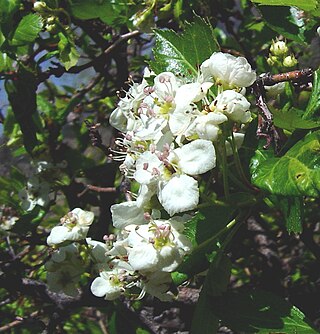
Crataegus erythropoda is a hawthorn native to the southern Rocky Mountains in the United States. The leaves are conspicuously shiny above and fruit ("haws") are dark purplish red. It is seldom cultivated, but at one time was listed in the nursery trade under the common name "Chocolate Haw". It is closely related to C. rivularis which has fruit that are fully black when ripe.
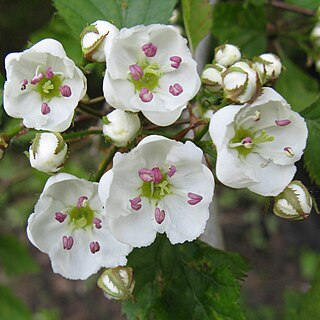
Crataegus holmesiana is a species of hawthorn closely related to Scarlet Hawthorn, C. coccinea, but with more elongated fruit and leaves.

Crataegus macrosperma, the bigfruit hawthorn is a species of hawthorn native to most of the eastern United States and adjacent Canada, though uncommon at lower altitudes in the south. It is sometimes misidentified as C. flabellata. It is one of the earliest hawthorns to bloom in spring.

Crataegus marshallii is a species of hawthorn known by the common name parsley hawthorn. It is native to the southeastern United States.
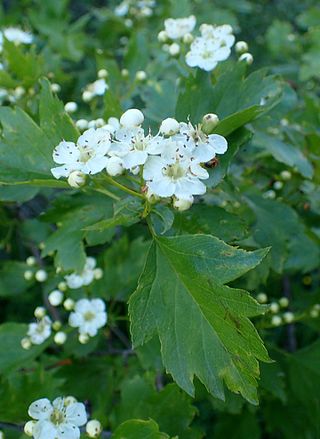
Crataegus nigra, the Hungarian thorn, Hungarian hawthorn or Black hawthorn, is a black-fruited species of hawthorn native to the western balkan and the Pannonian Basin, spanning from Slovakia to Albania. The fruit, which is up to 10 mm across, can be consumed fresh or cooked.

Crataegus pentagyna, also called small-flowered black hawthorn, is a species of hawthorn native to southeastern Europe. Two subspecies are recognized, C. p. subsp. pentagyna and C. p. subsp. pseudomelanocarpa. The fruit are usually black, but are sometimes a handsome purple.

Crataegus rivularis is a species of hawthorn known by the common name river hawthorn. It is native to the intermontane region of the northwestern United States, situated between the coastal ranges and the Rocky Mountains.
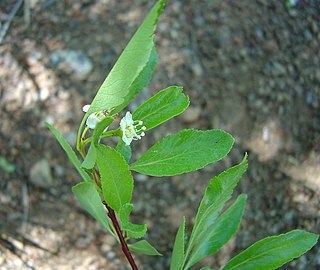
Crataegus saligna is a species of hawthorn known by the common name willow hawthorn that is seldom cultivated and rather rare in the wild. Its native range is wet areas of western Colorado and northeastern Utah. It is a shrub or small tree with thin, elongated leaves, small flowers, small black fruit, and reddish bark.
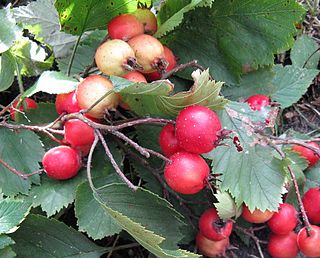
Crataegus submollis, known as the northern downy hawthorn, northern red haw, Quebec hawthorn, or hairy cockspurthorn, is a species of hawthorn that grows to about 7 m in height and typically carries large crops of red fruit.

Crataegus mexicana is a species of hawthorn known by the common names tejocote, manzanita, tejocotera and Mexican hawthorn. It is native to the mountains of Mexico and parts of Guatemala, and has been introduced in the Andes. The fruit of this species is one of the most useful among hawthorns.
Crataegus okanaganensis is a species of hawthorn native to western British Columbia, Washington state and Montana. It forms a vigorous shrub to 8 m in height with brilliant red fruit in late summer, that later ripen to "burgundy to deep purple ". It has potential as an ornamental plant.

Series Molles is a series within the genus Crataegus that contains at least six species of hawthorn trees and shrubs, native to Eastern North America. Some of the species are cultivated as ornamental plants. They have relatively large leaves, large flowers, and bloom early for hawthorns. The plant parts are usually hairy, particularly in early growth, and the fruit are generally red and are large for hawthorn fruit.

















